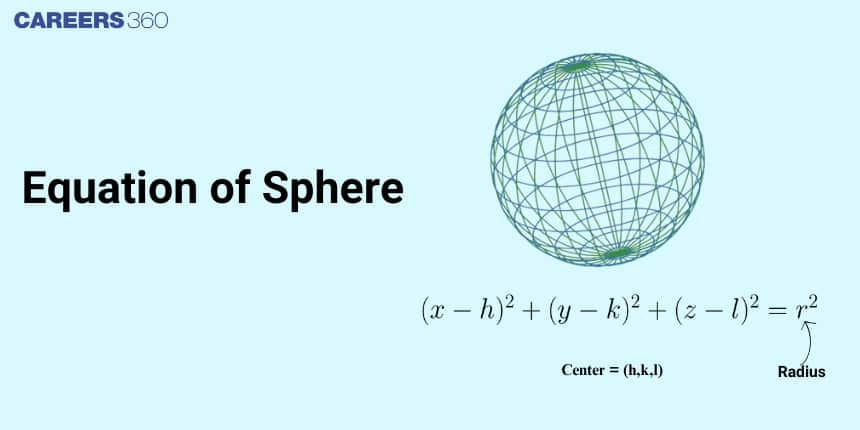Equation of Sphere
A Sphere is the locus of a point which moves in space in such a way that its distance from a fixed point always remains constant. The fixed point is called the centre of the sphere and the fixed distance is called the radius of the sphere. In real life, we use spheres to find the surface, volume, and diameter.
JEE Main: Study Materials | High Scoring Topics | Preparation Guide
JEE Main: Syllabus | Sample Papers | Mock Tests | PYQs
- Sphere: Definition
- Equation of Sphere
- Derivation of Equation Of Sphere
- Main elements of a sphere
- Properties of a Sphere
- Equation of sphere in diametric form
- Equation of sphere in cylindrical coordinates
- Equation of sphere in vector form
- Solved Examples Based on the Equation of Sphere
- Summary

In this article, we will cover the concept of the Equation of A Plane In The Normal Form. This topic falls under the broader category of Three Dimensional Geometry, which is a crucial chapter in Class 12 Mathematics. This is very important not only for board exams but also for competitive exams, which even include the Joint Entrance Examination Main and other entrance exams: SRM Joint Engineering Entrance, BITSAT, WBJEE, and BCECE. A total of six questions have been asked on this topic in JEE Main from 2013 to 2023.
Sphere: Definition
A Sphere is the locus of a point which moves in space in such a way that its distance from a fixed point always remains constant. The fixed point is called the centre of the sphere and the fixed distance is called the radius of the sphere.

Equation of Sphere
Spheres are the
If
Derivation of Equation Of Sphere
Let
Then,
From the distance formula
since,
NOTE:
NOTE:
If the centre of the sphere is at the origin the equation of the sphere is
The equation of the sphere can also be written as
Main elements of a sphere
Radius: The length of the line segment made between the centre of the sphere to some point on its surface.
Diameter: The length of the line segment starting from one point on the surface of the sphere and extending to the other point which is accurately opposite to it, surpassing via the centre is known as the diameter of the sphere. The length of the diameter is accurate, twice the length of the radius.
Circumference: The length of the immense circle of the sphere is known as its circumference. The edge of the dotted circle or the cross-section of the sphere holding its centre is called its circumference.
Volume: Similar to any other three-dimensional object, a sphere occupies some amount of space. This amount of space engaged by it is known as its volume. It is expressed in cubic units.
Surface Area: The area covered by the surface of the sphere is called its surface area. It is measured in square units.
Properties of a Sphere
The Following Properties of a sphere are:
- A Sphere is symmetrical in every direction.
- It has neither edges nor vertices.
- A sphere is not a polyhedron since it does not contain vertices, edges, and flat faces. A polyhedron is an entity that should have a flat face.
- Air bubbles adopt the shape of a sphere since the sphere’s surface area is the least.
- The sphere would have the greatest volume among all the shapes with a similar surface area.
Equation of sphere in diametric form
The equation of the sphere when extremities of the diameter are given is called the Equation of a sphere in diametric form. So, the equation of a sphere whose extremities of diameter are
Equation of sphere in cylindrical coordinates
In cylindrical coordinates, we have
Here, '
We know that the equation of sphere in the Cartesian coordinates system is
Since
Equation of sphere in vector form
The general vector equation of a sphere with centre
is given as
i.e.,
Recommended Video Based on Equation of Sphere
Solved Examples Based on the Equation of Sphere
Example 1: If the plane
Solution: Centre of
Centre of
Midpoint of
Hence, the answer is -
Example 2: The plane
Solution
Centre is
The perpendicular distance from the centre
Hence, the answer is
Example 3: If
Solution: Coordinate of center of sphere
Let other end be
Hence, the answer is
Example 4: The radius of the circle in which the sphere
Solution:
Center of sphere
Perpendicular distance
Hence,
Hence, the answer is 3
Example 5: The shortest distance from the plane
Solution:
Center of sphere
Hence shortest distance is
Hence, the answer is
Summary
The equation of a sphere,
Also Read
15 Feb'25 01:59 AM
15 Feb'25 12:41 AM
15 Feb'25 12:40 AM
15 Feb'25 12:25 AM
15 Feb'25 12:23 AM
15 Feb'25 12:19 AM
15 Feb'25 12:10 AM
15 Feb'25 12:07 AM
15 Feb'25 12:05 AM

